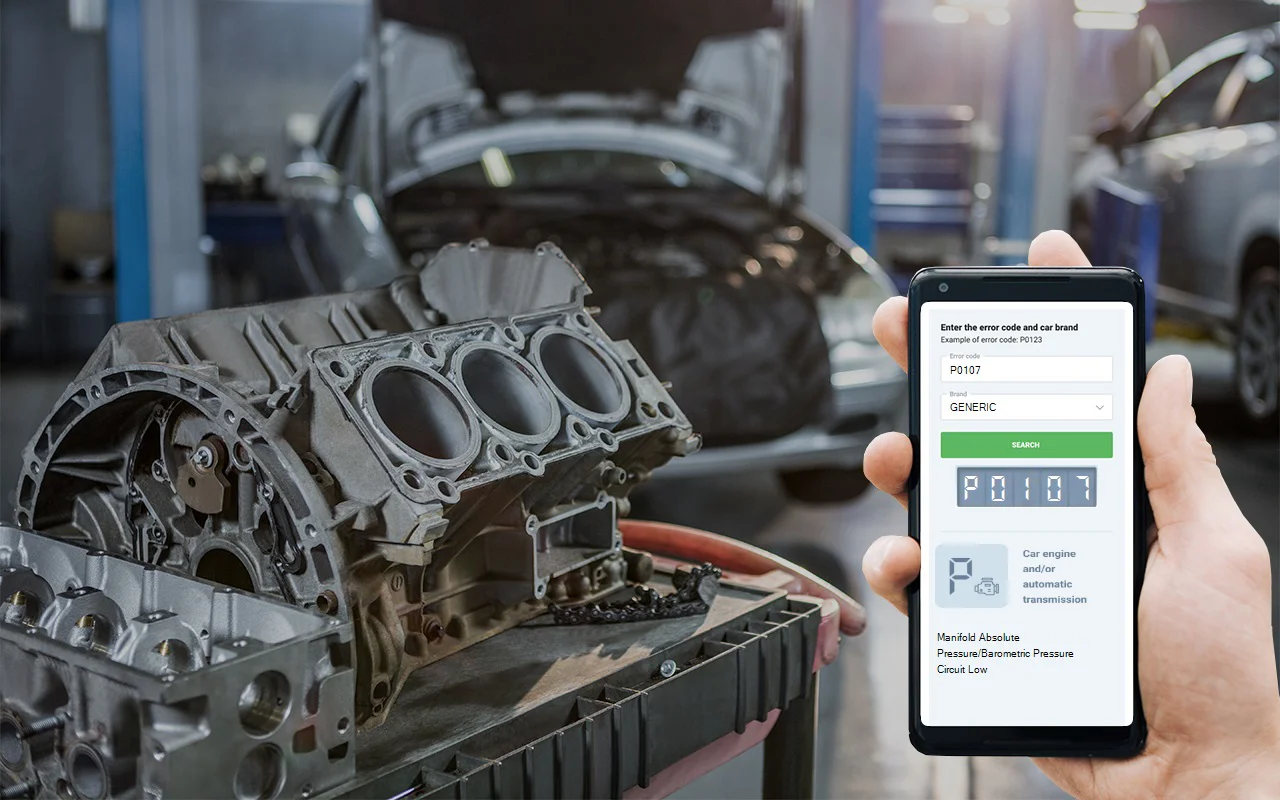Let me break down what code P0107 means for you. This code stands for “Manifold Absolute Pressure (MAP) Sensor/Barometric Sensor Low.” In plain English, your car’s computer (the PCM) is picking up a signal from the MAP sensor that’s lower than what it expects. The MAP sensor’s job is to measure the pressure inside your intake manifold, which helps the engine computer figure out how much fuel to deliver, control emissions, and keep everything running smoothly. If this sensor isn’t working right, or if there’s a problem with the wiring or vacuum, the computer can’t make the right decisions. That’s when you get this code. The MAP sensor is a key player in how your engine breathes and runs, so when it’s not happy, you’ll notice.
DTC P0107
P0107 code Causes
From experience, I can tell you that p0107 usually comes down to a few main culprits. Most often the issue is a faulty MAP sensor itself-these do wear out or get contaminated over time. But I’ve also seen plenty of cases where the wiring to the sensor is damaged, corroded, or just loose. Another common cause is a low engine vacuum, which can happen if there’s a vacuum leak or a mechanical problem inside the engine. And, though it’s rare, sometimes the engine computer (PCM) needs an update or has a fault. Here’s what I see most often:
- Defective MAP sensor
- Broken, frayed, or corroded wiring or connectors in the MAP sensor circuit
- Vacuum leaks or low engine vacuum
- PCM issues (like outdated software or, rarely, a failing module)
P0107 trouble code Symptoms
When this code pops up, you’ll probably notice a few things right away. The check engine light will come on, of course. But it’s not just a light-your car might start running rough, like it’s struggling to idle or accelerate smoothly. You could see your fuel economy drop, meaning you’re burning more gas than usual. In some cases, the engine might stall unexpectedly or surge up and down in RPMs. These aren’t just annoyances-they’re signs that your engine isn’t getting the right information to run properly. This error can also happen on Chevrolet, GM, Ford, and Renault vehicles.

dtc P0107 Diagnosis
Here’s how I usually tackle a eobd dtc p0107, step by step. First, I always start with the basics-pop the hood and check the MAP sensor and its wiring. Look for any obvious damage, loose connectors, or corrosion. Sometimes just unplugging and re-plugging the connector can clear up a poor connection. Next, I recommend using a scan tool to read live data from the MAP sensor; if it’s stuck at a low voltage (usually below 0.5 volts), that’s a big clue. After that, I check for vacuum leaks-listen for hissing sounds, and inspect vacuum hoses for cracks or disconnections. If everything looks good so far, I’ll test the MAP sensor itself, either by back-probing the connector with a multimeter or swapping it with a known good one if possible. Don’t forget to check the ground and power supply to the sensor, too. If all else fails, I’ll consider the PCM, but that’s pretty rare. It’s best to have someone assist you with the live data checks, and always make sure the ignition is off before unplugging anything.

obd code P0107 Common Mistakes
I’ve seen a lot of folks jump straight to replacing the MAP sensor without checking the wiring or vacuum lines first. That’s a surefire way to waste money and time. Another common mistake is overlooking a simple vacuum leak-sometimes a tiny crack in a hose is all it takes to set this code. Don’t forget to inspect the connector for corrosion or bent pins before moving on to more expensive parts. Skipping these steps can lead to frustration and unnecessary repairs. Some may also misdiagnose dtc p0107 chevrolet or gm dtc p0107 by not following a systematic approach.

P0107 Seriousness
Honestly, this isn’t something you want to ignore. When the MAP sensor isn’t working right, your engine can run too rich or too lean, which can cause poor performance, higher emissions, and even damage to your catalytic converter over time. In extreme cases, the engine could stall while you’re driving, which is a serious hazard. Things can go south quickly if this is overlooked, so don’t put it off for later-get it checked out as soon as possible to avoid bigger (and more expensive) problems down the road.
P0107 engine code Repair
In cases like this, the fix usually depends on what you find during diagnosis. Most often, replacing a faulty MAP sensor solves the problem. If the wiring or connectors are damaged, repairing or replacing them is the way to go. For vacuum leaks, replacing cracked or broken hoses is a must. On rare occasions, a PCM update or replacement might be needed, but that’s not common. Here’s what I typically do:
- Replace the MAP sensor if it’s faulty
- Repair or replace damaged wiring or connectors
- Fix any vacuum leaks by replacing hoses or gaskets
- Update or reprogram the PCM if required (rare)
Conclusion
To sum it up, P0107 means your engine’s MAP sensor is reporting a voltage that’s too low, which throws off how your car runs. It’s not something to take lightly-left unchecked, it can lead to rough running, poor fuel economy, and even engine damage. The best approach is to start with simple checks: look at the sensor, wiring, and vacuum lines before replacing parts. Acting quickly and methodically is the most reliable way to get your car back to running right and keep you safe on the road.
- P0107 Manifold Air Pressure (MAP) Barometric Pressure Sensor Circuit Low Voltage Input Problem

- How to Fix P0107 Engine Code in 2 Minutes [1 DIY Method / Only $11.58]

- Causes and Fixes P0107 Code: Manifold Absolute Pressure / Barometric Pressure Sensor Circuit Low

- Ertiga Diesel Low Power DTC P0107 P0243 C1091 Finish Repair?





